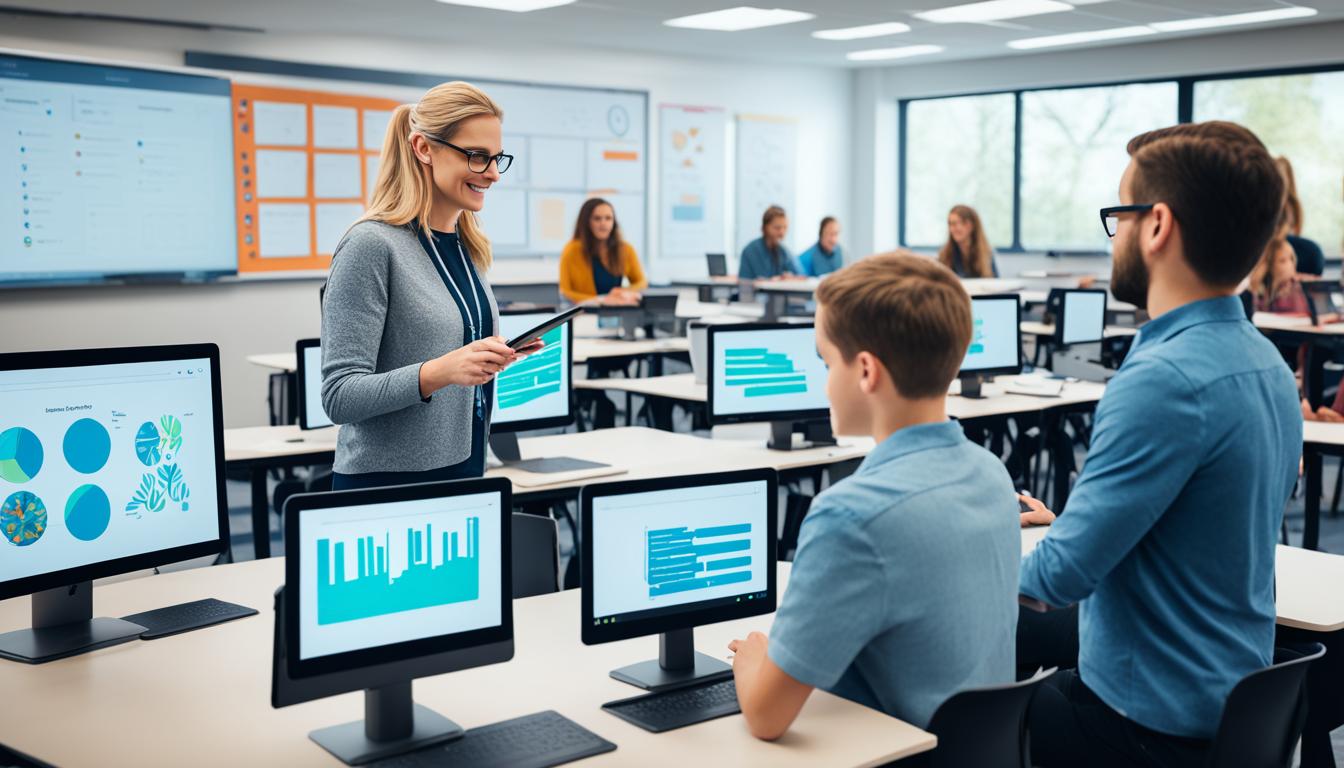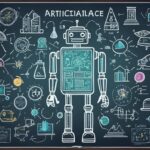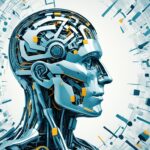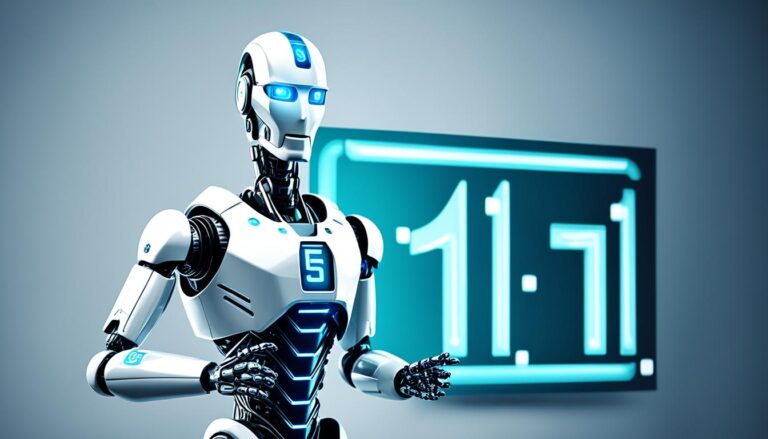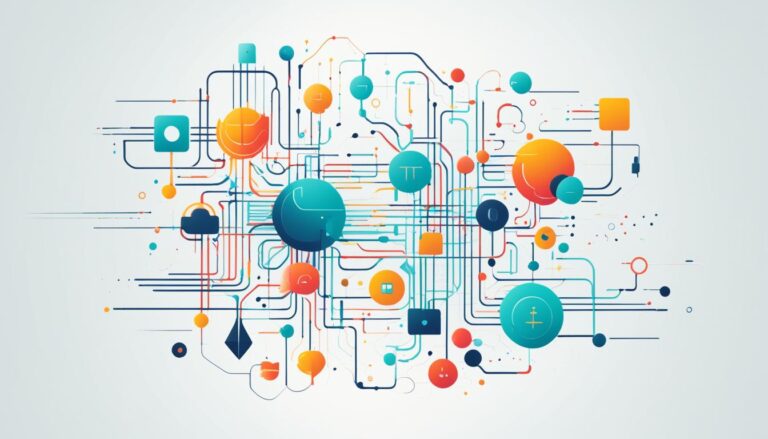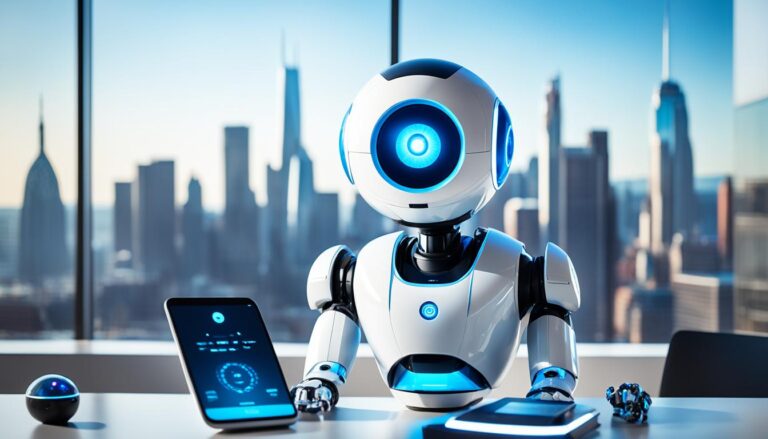Artificial Intelligence (AI) is changing education in a big way. It’s making learning better and teaching methods more effective. The growth of AI in computers and education cannot be ignored.
AI helps create personalized studies, takes care of routine tasks, and makes learning material smarter. It lets lessons adapt to what each student needs. With AI, teachers can understand their students’ progress in real-time. This means they can help students more.
The use of AI in teaching and learning is growing fast. This change is opening new doors in education. AI is set to make learning more innovative, efficient, and effective. We’ll look more into how AI is doing this in the next sections.
Enhancing Personalized Support for Teachers at Scale
AI technologies have changed how we support teaching and learning. They provide tailored support for teachers broadly. These tools boost teaching methods and aid in their professional growth. They offer priceless resources for educators.
AI helps teachers by simulating student interactions. This is great for new teachers. They can hone their teaching skills in a safe, virtual space. This boosts their confidence and improves their teaching techniques.
AI also gives instant feedback and tips to teachers. This helps them make better decisions and update their teaching methods. For example, it might suggest new ways to explain tough concepts. Or, it might offer custom resources for each student. AI gives teachers useful insights.
Moreover, AI lets teachers keep up with the latest in their field. They can access AI tools and platforms. This helps them try new teaching methods, use new technologies in their lessons and keep improving.
The widespread use of AI in education gives teachers personalized support. It meets their specific needs and helps them do better in their jobs. By using AI, teachers can better their teaching methods. They can make classes more interesting for students and keep growing professionally.
Example AI Tools for Teacher Support
| AI Tool | Description |
|---|---|
| Virtual Teaching Assistant | An AI-powered assistant that helps teachers with admin tasks, creating lesson plans, and giving personalized feedback to students. |
| Professional Development AI | An AI platform that finds and suggests the right professional development resources for teachers, based on what they need and like. |
| Real-Time Classroom Analytics | An AI program that collects and analyses data from class activities in real-time. This helps teachers make choices based on solid data. |
| Intelligent Content Generation | An AI tool that creates customized learning materials, quizzes, and assignments. It meets each student’s needs and helps keep them engaged. |
Changing What is Important for Learners
Artificial Intelligence (AI) is changing education and how learners study. It has shifted the focus from just learning skills to promoting deep involvement and critical thought.
AI technologies offer custom learning that suits each student’s unique needs. This allows students to be more creative than traditional study methods.
The move towards AI has its challenges and worries. Some people are concerned about its effect on critical thinking skills. They fear that relying too much on AI could harm our ability to think and analyze on our own.
To grasp AI’s effect on students, we must look at both its benefits and drawbacks. The mix of AI and custom learning brings new chances for education that meets various needs and styles.
It is key to find a middle ground in using AI and fostering critical thinking. Schools must use AI to boost learning without replacing the need to develop thinking skills.
“AI allows learners to focus on sharpening their critical thinking. They can dive into complex problem-solving and creativity, encouraging deeper learning.” – Dr. Jane Thompson, Education Specialist at Oxford University
The Impact on Skill Development and Future Success
AI introduces big changes in education that affect future skills and success. It promotes critical thinking and close involvement, readying students for a job market that values adaptability and creativity.
AI helps develop key skills for a world that constantly evolves. Being able to analyze, evaluate, and create is very important.
This balance between AI’s benefits and skill development is crucial. We must mix AI with group work, debates, and hands-on tasks for comprehensive education.
AI and custom learning can hugely change education. They promote critical thinking skills. But, it is important to use AI wisely to enhance learning, not hinder the growth of crucial thinking skills.
| Benefits | Concerns |
|---|---|
| Personalized learning experiences | Potential outsourcing of critical thinking tasks |
| Deeper engagement and critical thinking | Potential impact on critical thinking skill development |
| Exploration of creative and ambitious pursuits | Need to strike a balance between AI and cognitive skill development |
Enabling Learning Without Fear of Judgment
Artificial Intelligence (AI) can make learning safe from judgment. With AI tools like chatbots, students get personal feedback. This builds their courage to try new things in learning. Soft skills growth, which is hard to teach, benefits too.
For soft skills like teamwork and adaptability, AI is key. These skills are vital today but need a supportive environment to grow. AI lets students practice these in private, boosting their confidence.
AI for Soft Skills Development
Soft skills help us work well with others and are key for success. Teaching them is hard because they’re about feelings and hard to measure. AI gives custom support to help learners grow these skills.
AI helps students by giving focused advice. It offers exercises that mimic real life for practicing soft skills. This helps students gain confidence and explore without worry.
With AI, students can role-play and try out tough talks. They get good feedback and can learn from mistakes safely. They don’t have to fear being judged.
AI also makes learning fit each student’s needs. It adjusts to their learning style and speed. This helps students overcome challenges in developing soft skills.
By using AI, schools help students become confident and good communicators. This prepares them for the future.
https://www.youtube.com/watch?v=Gvf8oQDcLsQ
Reducing Fear of Judgment in Learning
Fear of judgment can slow students’ learning. AI offers a learning space that’s free from judgment. It gives support, not criticism, helping students feel safe.
AI’s instant feedback helps students learn with confidence. They can try things out and learn from errors. This encourages a learning mindset and helps them improve.
AI allows learning through trial and error. It supports a positive learning attitude. Students can try various methods and get help from AI along the way.
AI creates a space where students can own their learning. They can reach their full potential. It builds resilience and self-belief for their education and future.
Improving Learning and Assessment Quality
AI technologies are changing education by improving learning and assessments. They make personalized learning experiences possible. This means students get feedback meant just for them and connect more with what they’re learning. This special way of learning helps students understand and remember better, leading to great academic success.
AI-powered personalized learning is changing education. It matches learning to each student’s unique needs and pace. Educational platforms use AI to analyze data and make learning paths that fit each student. This ensures students get the best resources and activities for them.
AI in education finds out where students need more help. By looking at how students perform, AI can tell where they struggle. This helps teachers give the right support quickly and effectively fill those learning gaps.
AI is also important in making grading faster and more reliable. It can look at a lot of student work, like exams and projects, quickly. This lets teachers give more personal and useful feedback, helping students learn deeper.
AI assessment systems help teachers understand how students are doing. Using advanced algorithms, these systems look at student answers, follow their progress, and offer helpful data. This data helps teachers teach better and improve how students learn.
AI can also help students find careers that fit their skills. By knowing what abilities students have, AI suggests career paths and education plans. This helps students learn the right skills for jobs in demand, making them more ready for the future job market.
AI for Personalized Learning
- It adjusts to every student’s needs and how they learn.
- It looks at a lot of data to make personal learning plans.
- It uses special resources and activities to help students understand and remember better.
AI in Assessment
- It makes grading faster and more consistent.
- It gives useful data to help teachers teach better.
- It takes over tasks that take a lot of time, letting teachers focus on personal feedback.
AI for Skills Identification
AI systems can find where students need more help and give focused support.
Education is being greatly improved by AI, leading to personalized learning and better assessments. AI lets teachers provide instruction that’s just right for each student. It helps students reach their highest potential and makes education better. As AI grows and becomes a bigger part of education, the future of learning is bright and full of possibilities.
Addressing the Risks of AI in Education
AI offers great benefits to education, but we must also consider its risks. It’s important to look at the limitations and challenges AI could bring to education. These need careful thought to ensure education keeps improving.
One big issue is when AI models in education don’t offer enough cultural diversity. They might not fully show the diversity of our cultures and communities. It’s crucial to make AI models more diverse. This way, education will include everyone’s unique experiences and points of view.
“The lack of cultural diversity in AI models can result in the perpetuation of biases and reinforce existing social inequalities within education”
There’s also a risk that AI might focus more on being fast than on helping students learn. AI might give quick answers that aren’t always right or complete. This can be bad for students’ learning. Finding the right balance between quick AI help and real learning is key.
Advances in AI can also make students wonder if their skills will still be needed. They might not see the point in what they are learning. It’s important to help students see that they can grow and adapt to new challenges.
“AI advancements have the potential to create a motivation crisis among students who may question the relevance and value of their skills in a rapidly evolving technological landscape”
To use AI well in education, we need to understand and face these challenges. We should make sure AI models represent everyone fairly. AI should also focus on helping students really understand, not just on being fast. And, we need to help students stay motivated to learn and grow.
Risks Associated with AI in Education
| Risks | Description |
|---|---|
| Lack of Cultural Diversity | AI models may not reflect true cultural diversity, leading to inequitable representation and lack of authentic voices. |
| Focus on Speed over Learning | AI responses may prioritize providing quick answers instead of optimizing for student comprehension and understanding. |
| Motivation Crisis | AI advancements can exacerbate a motivation crisis among students who question the value of their skills in the face of rapid technological progress. |
It’s vital to tackle these AI risks in education to use it right and safely. By focusing on learners and being inclusive, AI can really make education better. It can prepare students for what’s ahead.
Conclusion
AI is changing how we teach and learn. It’s making learning more personal and helping teachers improve.
Yet, we must be cautious. It’s important to think about how we use AI safely and fairly in schools.
We’ve looked at how AI can make education better. As AI gets better, it will bring more changes.
By using AI wisely, we can make sure everyone gets a better education. We can prepare students for a future with AI.
FAQ
How is AI transforming computers and education?
AI has the power to change education by using tech to better teaching and learning. It brings innovations like personalized learning, ease in admin tasks, and smart content making. Already, AI helps tailor lessons for every learner, simplifying tasks for educators.
How does AI enhance personalized support for teachers?
AI gives teachers personalized help, improving how they teach. It can mimic students, so new teachers can practice skills. Also, it offers real-time advice, helping teachers decide better in class.
How is AI changing what is important for learners?
AI changes learners’ focus to deep engagement and thinking critically. It means students can be more creative instead of just writing or computing. AI adjusts to each student’s needs, offering tailored learning.
How does AI enable learning without fear of judgment?
AI offers a space where students feel safe to learn without fear. With tools like chatbots, they get personal and helpful feedback. This helps them try harder, particularly in developing tough skills.
How does AI improve learning and assessment quality?
AI is boosting the quality of learning and tests. It offers customized learning, allowing for deeper engagement. AI spots where students need help and suggests fixes. For exams, it offers quick and fair marks.
What are the risks associated with AI in education?
AI in education comes with challenges. It might not show true cultural diversity, leading to unfairness. Sometimes, AI focuses more on being fast than on helping students learn properly. Also, AI’s quick growth might make students doubt the value of their skills.
What is the conclusion regarding AI in education?
AI is revolutionizing education by transforming how we teach and learn. It promises personalized lessons, better tests, and support for teacher development. Yet, it’s vital to tackle its risks. If we use AI ethically and safely, we can make education better and more inclusive.
